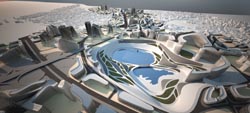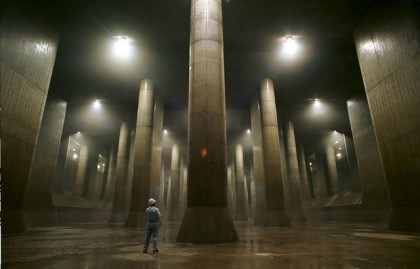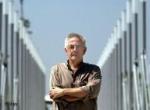Albert Speer Jr, an architect and urban planner like his father, helped design the master plan for Beijing’s Olympics. He was tasked with laying out the plan for access to the Olympics complex, focusing on the construction of an imposing avenue, which connects the Forbidden City and the National Stadium, aka Bird’s Nest.
From The Guardian and The Times of London.
 Jacques Herzog on choosing to build in China:
Jacques Herzog on choosing to build in China:
Only an idiot — and not a person who thinks in moral terms would have turned down this opportunity — would have said no. I know that there are architects who now claim that they would never have even considered building in China. This is both a naïve and arrogant position, one that reflects a lack of knowledge of and respect for the incredible cultural achievements this country has continuously provided over the last 5,000 years and still provides today.
From China Daily:
After the Games, the stadium will be redeveloped to include hotels, restaurants, supermarkets and shopping malls, he said.
The reconstruction will cost at least 300 million yuan and after it, commercial buildings will cover about 35 percent of the entire compound.
Wonder what Herzog de Meuron thinks about this. . . .

Zaha Hadid's master plan for the Kartal area of Istanbul, with the Sea of Marmara visible at the top.
From the Wall Street Journal:
“We are seeing an emergence of a new industry,” says Dennis Frenchman, director of the city design and development program at the Massachusetts Institute of Technology’s urban-studies department. “It’s not real-estate development; it’s not architecture; it’s not city planning. All I can do is name it ‘the city-building industry.’ “
And a name-brand architect can make the product sellable. “It’s just like teapots,” he says.
[. . .]
Name-brand master plans are “an entrepreneurial tool” that are key to getting these large projects built, says Reinier de Graaf, an OMA partner working with Mr. Koolhaas on the Riga and Waterfront City projects. Urban planning is now “a very weird mixture of marketing and urbanism,” he says.
Mr. Chipperfield agrees. “It’s easier to know about architects than architecture,” he says. “A banker won’t know about architecture but will know that ‘Zaha Hadid’ or ‘Rem Koolhaas’ is a brand.”
Roll call:
- Zaha Hadid: Kartal, a suburb on the Asia side of Istanbul – groundbreaking in 2009
- Zaha Hadid: 60 hectares of a peninsula in the river in Bilbao; the Zorrozaurre plan will turn the land into an island, with angled buildings for housing and offices following the curve of the river – currently being developed
- Rem Koolhaas/OMA: Waterfront City, artificial island in Dubai — landworks started, decades to completion
- Rem Koolhaas/OMA: Riga’s port, 100-acre site — 2006 plan
- Daniel Libeskind: Orestad, a five-kilometer-long urban area south of Copenhagen – to be completed around 2016
- Daniel Libeskind: Fiera Milano, 43 hectares of Milan’s old fairgrounds – to be completed in 2014
- David Chipperfield: new art and technology quarter in Segovia — won competition in March 200
And its people and streets and pets and food and pirated DVDs….
- Price: $43,000,000,000 (US)
- When no-smoking ban went into effect for Beijing restaurants: May 2008
- Dog meat removed from all menus: May 2008
- Flowers ordered: 40,000,000 pots
- Size of forest created next to Olympic Stadiums to improve air quality: 2x Central Park, NYC
- Number of Beijing taxi drivers who have undergone a special English training program: 90,000
- Participants on online etiquette training course: 17,000,000
- Residents moved to make way for Olympic-related projects: 1,500,000
From “Beijing goes to extremes for its Olympic face-lift,” Los Angeles Times.
Once dubbed by Esquire magazine as “the worst building in the history of mankind,” the 105-story Ryugyong Hotel is back under construction after a 16-year lull in the capital of one of the world’s most reclusive and destitute countries.
Accompanying the Vanity Fair article by Kurt Andersen, Vanity Fair online has a slideshow of CCTV, the Bird’s Nest, Aquatic Center, Linked Hybrid, the new airport, and the National Center for the Performing Arts in Beijing. Photos by Todd Eberle and Stephen Wilkes.

Steven Holl’s Linked Hybrid complex contains 750 apartments, a hotel, a movie theater, shops, cafés, and a school. Photograph by Stephen Wilkes.
From Arch Daily, some great videos of the storm sewer system of Saitama, Japan.
Official website here.

rom the Wall Street Journal:
In the last year, Toyota Home, as Toyota’s housing division is known, launched an aggressive advertising campaign to make more consumers aware of the brand, opened showrooms and hired architects to help redesign its lineup of homes — which consumers complained had more function than style.
Toyota’s aspirations as a home builder are also gaining new importance with the planned launch by 2010 of its plug-in vehicles, gas-electric hybrid cars with powerful lithium-ion batteries that drivers will need to recharge at home. The car maker is testing an electricity-monitoring system in its homes that would charge the vehicle during off-peak hours to keep utility bills low, while the car’s battery can serve as an electrical backup, powering the home during blackouts.



